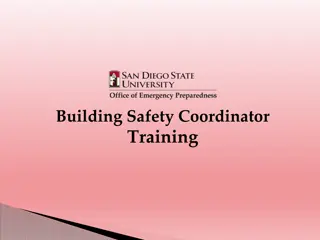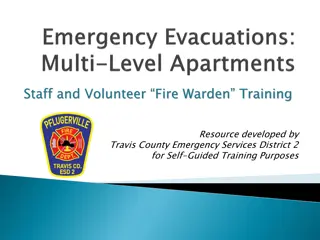Fire Safety Measures - Level 2 Module Lesson 4
Learn essential fire safety measures to prevent fires and protect yourself during emergencies. Understand fire risks, prevention techniques, and safe practices in the kitchen, with electrical cords, candles, smoking, and storage of flammable materials. Stay informed and prepared for potential fire hazards.
Download Presentation

Please find below an Image/Link to download the presentation.
The content on the website is provided AS IS for your information and personal use only. It may not be sold, licensed, or shared on other websites without obtaining consent from the author.If you encounter any issues during the download, it is possible that the publisher has removed the file from their server.
You are allowed to download the files provided on this website for personal or commercial use, subject to the condition that they are used lawfully. All files are the property of their respective owners.
The content on the website is provided AS IS for your information and personal use only. It may not be sold, licensed, or shared on other websites without obtaining consent from the author.
E N D
Presentation Transcript
FIRE SAFETY MEASURES LEVEL 2 MODULE LESSON 4 LIFE ORIENTATION 1 LESSON PREPARED BY MS MINNIE
http://t1.gstatic.com/images?q=tbn:ANd9GcRshk9eXTRAxrjzYw1CdUrBIf-lojcWo1VGB2FSZHDz5B3759CK5yLSR7z_http://t1.gstatic.com/images?q=tbn:ANd9GcRshk9eXTRAxrjzYw1CdUrBIf-lojcWo1VGB2FSZHDz5B3759CK5yLSR7z_ Fire safety All fires are dangerous and life threatening. Make sure you have knowledge on how to prevent fires. It is also essential that you should know how to act when you encounter a fire. Your safety should be of primary concern when you are attempt to fight a fire. 2 LESSON PREPARED BY MS MINNIE
What are fire risks? Anything that can start a fire such as naked flames or heaters. Anything can burn in a fire such as textiles or paper. Oxygen sources such as air conditioners. 3 LESSON PREPARED BY MS MINNIE
Fire risks and how to prevent fires Do not leave the kitchen unnecessarily when cooking Watch hot oils Use microwave proof dishes in the microwave Keep flammable cloths away from the stove Do not store flammable products near the oven Do not wear long loose fitting clothes when cooking Kitchen http://t0.gstatic.com/images?q=tbn:ANd9GcR9OZ2MWSMxVSxuCQV5c6HHpiJsp-ivLAZF0bqJ0se4FtvVowO5EVSdOW0 Be careful of pets chewing wires Do not cover plugs with mats where people walk When connecting two electrical wires cover with insulation tape Electrical cords and wires Do not leave blankets or flammable materials near a heater or electrical equipment Flammable materials 4 LESSON PREPARED BY MS MINNIE
Fire risks and how to prevent fires Never leave candles unattended Do not put a candle near flammable materials Do not sleep with a candle burning when sleeping Candles Never smoke in bed Do not leave a burning cigarette unattended Do not throw away a still burning cigarette butt Empty ashtrays with smoldering cigarette butts Make sure fires are far away from any flammable materials Ashes from fires should be completely cold before being left unattended. Smoking Open fires 5 LESSON PREPARED BY MS MINNIE
Fire risks and how to prevent fires All flammable materials should be stored safely away from any source of heat Storage of flammable materials Do not put too many plugs in one power outlet Plugs Do not connect power from one house to another Illegal connections 6 LESSON PREPARED BY MS MINNIE
http://t0.gstatic.com/images?q=tbn:ANd9GcSN2g2mrAwFRoWzPrNRvQmSSZHIXbqGuHoiHHv9sqC3mqA21A826DOZzJ0http://t0.gstatic.com/images?q=tbn:ANd9GcSN2g2mrAwFRoWzPrNRvQmSSZHIXbqGuHoiHHv9sqC3mqA21A826DOZzJ0 Should you fight fires? All fires are dangerous and can be potentially life threatening. Before you fight a fire take note of the following: Is the fire small and not spreading? Do you have the proper fire extinguisher for what is burning ? Make sure the fire won t block your exit if you can t control it Know how the fire extinguisher works Know how to use a fire extinguisher 7 LESSON PREPARED BY MS MINNIE
How to fight fire safely? Always stand with an exit at your back Stand several feet away from the fire Use a sweeping motion and aim at the base of the fire Use a buddy system to have someone back you up or call for help if something goes wrong. Be sure to watch the area for a while to ensure that the fire does not re-ignite. 8 LESSON PREPARED BY MS MINNIE
What to do in a fire emergency? Alert everyone Get everyone out http://t2.gstatic.com/images?q=tbn:ANd9GcTy6VJILnlrtTlGU5_d-FelEcvhYbyNlaJcQpmaNN-w6LHBspFIHnC8PhU If your clothes catches fire: Stop Drop Roll 9 LESSON PREPARED BY MS MINNIE
Fire emergency tips When you cannot get out by your escape route try alternatives. Go out the window. Break the window if you need to. Be careful of sharp glass. 10 LESSON PREPARED BY MS MINNIE
http://t0.gstatic.com/images?q=tbn:ANd9GcSWoYdg_-0QKCwc0AxRlSfSAnVSh2meJ9-QpXJ7OyI0d8V--QvzWcGwdQhttp://t0.gstatic.com/images?q=tbn:ANd9GcSWoYdg_-0QKCwc0AxRlSfSAnVSh2meJ9-QpXJ7OyI0d8V--QvzWcGwdQ Fire emergency tips If you cannot get out, get everyone into one room Chooses a room with a window Put cushions and bedding at the bottom of the door to block the smoke Open a window and call for help Do not touch the door handles as it may be hot Once out do not go back in 11 LESSON PREPARED BY MS MINNIE
Basic first aid for burn victims A burn is any damage to the skin or other tissue caused by dry or moist heat, chemical action, electrical energy or radiation. Most burns occur in the home and the victims are usually the elderly or the young. 12 LESSON PREPARED BY MS MINNIE
Basic first aid for burn victims Burns are classified into: Surface burns (first degree burns) the upper layers of the skin are damaged. Blistering (second degree burns) the skin is red, swells and blisters form. Deep burns (third degree burns) the outer layers of the skin are destroyed. The skin may be charred and there may be other areas of superficial burns. 13 LESSON PREPARED BY MS MINNIE
Basic first aid for burn victims There is usually pain and swelling. There is danger of infection because the skin is broken. Burns result in fluid loss and causes shock to the body, the aim is to keep the damage to the minimum. 14 LESSON PREPARED BY MS MINNIE
Keeping the damage to a minimum Remove the patient from the heat or fire. Immediately reduce temperature of the burned area by putting the injured part in cold water. Do NOT apply butter. Cool off the entire area as heat in the burned tissue continues to spread. Remove burnt clothing if possible while continuing to flush the area. Assess breathing and give mouth-to-mouth resuscitation if necessary. Cover the burnt area lightly with a sterile dressing. Treat for shock. 15 LESSON PREPARED BY MS MINNIE























